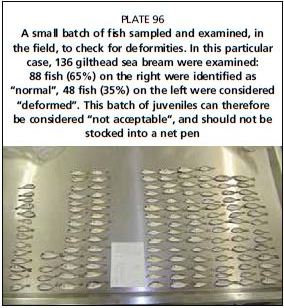FISH NUMBER COUNTS

Production cycles in cages may last for many months, and updating the biomass information of each cage is essential for managing the stock well. This biomass evaluation is essential to be able to calculate accurately the quantity of feed needed, and for planning the harvesting, sale and future stocking schedules.
No instrument is available capable of providing accurate counts of fish in a cage. Therefore, the best approach is to maintain an accurate record of the numbers of fish stocked and removed from the pen, and to minimize any uncontrolled variations in these numbers.
The biomass of a batch is obtained by multiplying the number of fish by the average weight of the fish. The average weight of the fish can be determined by taking a sample of the batch in the cage. However, in order to estimate the entire biomass, the number of fish at the moment of sampling needs to be known. An inaccurate assessment of the number of fish will result in several biomass- related errors, which can be detrimental to the company's accounts as well as to the surrounding environment.
An overestimation of the fish biomass will result in overfeeding, which means an increase in feed wasted on the site, with a consequent negative impact on the environment and a higher FCR (and higher production costs). On the other hand, underestimating will result in a reduced amount of feed provided to the fish. Underfeeding will lead to a reduction in growth rate, which lengthens the overall production cycle. It can also lead to stress-induced immunosuppression, leading to greater potential for disease outbreaks and reduced fish value or survival.
An accurate estimate of the biomass allows the appropriate planning and assessment of the future production of the farm, as well as permitting tracking of the growth of the different batches of fish.
To reduce the risk of biomass errors, it is essential to: (i) record accurately the input of new fish; (ii) record mortalities, sampling and harvesting; and (iii) minimize the effects of uncontrolled output such as escapes, theft, predation and cannibalism. Each of these topics is discussed in more detail below.
Fish inputs
The initial fish count can be quantified or measured in several ways:
• Manual counting. After the fingerlings have been anaesthetized, they can be counted one by one. This method can only be applied to small batches. It is a time-consuming method, but provides an exact count.
Automatic electronic counting. There are several fish counting machines available, but they are expensive and are usually not available at the hatcheries. An error of about three percent can be expected when using these machines.
Statistical estimate. This is the commonly used method and is based on calculating the average weight of one fingerling from a sample, as well as the total weight of fish received from the hatchery. To conduct a sample, several fingerlings are netted and placed into buckets or basins filled with a previously measured amount of water. A known number of fish are added, and the net weight is calculated and recorded. The difference between the final weight and initial weight will be the total weight of all of the fish, which is divided by the number of fish to calculate the average. Several average weight estimates should be made during the loading operation. In general, larger samples will produce more accurate and precise results. Depending on the way of conducting this measurement, 1-3 percent should be deducted to account for water weight.
Controlled fish output
The controlled outputs can be quantified by simply counting or estimating the number of fish that are deliberately or actively removed from the cage by the farmer. Controlled outputs are possible when recording fish mortalities and during fish transfers, sampling and harvesting:
Mortality: Dead fish must be periodically removed from the cage, counted and disposed of as special waste. Any variation in the pattern of mortality could indicate a disease outbreak and should lead to immediate pathological inspection, and to diagnosis and cure or other response. The expected and acceptable percentage mortality depends on the species, the environment and the rearing conditions. Transfers, sampling and harvesting: It is essential to record all the inputs and outputs of fish transfers for each batch. It is helpful to compile a periodical stock report, with the updated status of each cage.
Uncontrolled fish output
The causes of uncontrolled fish loss must be minimized as much as possible: • Accidental escapes may be drastically reduced by applying a plan of control and maintenance of nets and cages as discussed in Chapter 6. Nets must be kept clean by regularly changing them or cleaning them with a high-pressure cleaner. This avoids the build-up of biofouling, which makes the nets heavier, and thus represents a potential cause of net failure. Increased controls are necessary when culturing grazing species because the risk of breaches in the netting is higher as a result of net bites.
• Predation must be countered through the use of predator nets. It is possible that large predatory fish (e.g. amberjacks) can be unintentionally introduced into the cages during a batch transfer between cages. In these cases, predators need to be removed from the cage to reduce the risks of fish loss.
• Cannibalism is a naturally occurring behaviour in many species. It can be minimized by reducing the variation in fish size so to ensure size homogeneity as much as possible. It is possible to reduce the size spread by ensuring that fingerlings are inspected before they leave the hatchery, together with correct feed management on the farm site.
Theft can be reduced through surveillance of the site, by either humans or video equipment. Surveillance of the fish farm is highly recommended.